Haier DW9-AFM Handleiding
Haier
Vaatwasser
DW9-AFM
Bekijk gratis de handleiding van Haier DW9-AFM (12 pagina’s), behorend tot de categorie Vaatwasser. Deze gids werd als nuttig beoordeeld door 58 mensen en kreeg gemiddeld 4.7 sterren uit 29.5 reviews. Heb je een vraag over Haier DW9-AFM of wil je andere gebruikers van dit product iets vragen? Stel een vraag
Pagina 1/12

Cleaning and Special Maintenance
Filter Assembly
For the best performance and results, the filter assembly must
be cleaned.
The filter efficiently removes food particles from the wash water,
allowing it to be recirculated during the cycle. For this reason, it
is a good idea to remove the larger food particles trapped in the
filter after each wash cycle by rinsing the "A" semi-circular filter
and cup under running water. To remove the filter assembly, pull
on the cup handle in the upward direction. The entire filter as-
sembly (made up of the "A" semicircular filter and the "B" fine
filter) should be cleaned at least once a month. To clean the filter
and the fine filter, use a cleaning brush. Then, reassemble the
filter parts as shown in the figures below and reinsert the entire
assembly in the dishwasher, positioning in its seat and pressing
downward.
The dishwasher must never be used without the filters. Improper
replacement of the filters may reduce level of the appliance and
damage dishes and utensils.
Cleaning the Spray Arms
It may happen that food particle become encrusted on the sprayer
arms and block the hole. Check the sprayer arms periodically
and clean them when needed. (See "Close up view [interior]" ,
letters C-E ).
Cleaning the Water Inlet Filter
Periodically clean the water inlet filter (see figure 1/A) located on
the outlet of the water supply tap.
After turning off the water tap, unscrew the end of the water sup-
ply hose, remove the filter and clean it carefully under running
water. Then, return the filter to its place and tighten the water
supply hose back into position.
Installation
Positioning the Appliance
Position the appliance in the desired location. The back should
rest against the wall behind it, and the sides, along the adjacent
cabinets or wall. The dishwasher is equipped with water supply
and drain hoses that can be positioned to the right or the left to
facilitate proper installation.
Levelling the Appliance
Once the appliance is positioned, adjust the feet (screwing them
in or out) to adjust the dishwasher, making it level. In any case,
the appliance should not be inclined more than 2 . If the appli-
ance is level, it will help ensure proper performance.
Cold Water Connection
Connect the cold water supply hose to a threaded 3/4 (gas) con-
nector and make sure that it is fastened tightly in place (see fig.
1).
If the water pipes are new or have not been used for an extended
period of time, let the water run to make sure that the water is
clear and free of impurities. If this precaution is not taken, there
is a risk that the water inlet can get blocked and damage the
appliance.
Hot Water Connection
The water supply to the appliance can also be connected to the
house's hot water line (centralised system, heating system), as
long as it does not exceed a temperature of 60 .
In this case, the wash cycle time will be shortened by about 15
minutes and the wash efficiency slightly reduced.
The connection must be made to the hot water line following the
same procedures as those for the connection to the cold water
line.
Drain Hose Connection
Insert the drain hose into a drain pipe with a minimum diameter
of 4cm, or let it run into the sink, making sure to avoid bending
or crimping it. Use the special plastic support that comes with
the appliance (see fig.2). The free end of the hose must be at a
height between 40 and 100 cm and must not be immersed in
water.
Attention:
The special plastic hose support must be solidly fastened to
the wall to prevent the drain hose from moving and allowing
water to spill outside the drain.
Electrical Connection
After making sure that the voltage and frequency values for the
current in the home correspond to those on the rating plate
(located on the stainless steel inner door of the appliance) and
that the electrical system is sized for the maximum voltage on
the rating plate, insert the plug into an electrical socket which
is earthed properly (the earthing of the appliance is a safety
requirement mandated by law).
If the electrical socket to which the appliance must be connected
is not appropriate for the plug, replace the plug, rather than
using adaptors or the like as they could cause overheating and
burns.
MAX 100 MIN 40
S
fig.2
Troubleshooting
It may occur that the dishwasher does not function or does not
function properly. Before calling for assistance, let us see what
can be done first: have you forgotten to press one of the buttons
or to perform an essential operation?
The Dishwasher Does Not Start
Have you checked whether:
- the plug is pushed into the socket correctly;
- the power is on in the house;
- the door is closed properly;
- the ON-OFF switch is on "ON";
- the water supply is turned on.
The Dishwasher Does Not Load Water
Have you checked whether:
- the water is turned on and the hose is
connected properly;
- the water supply to the house on and has
sufficient pressure;
- the water supply hose is crimped or bent;
- the filter for the water supply hose is clogged.
The Dishes Are Not Clean
Have you checked whether:
- the water is turned on and the hose is
connected properly;
The Dishwasher Does Not Drain
Have you checked whether:
- the drain hose is crimped or bent.
Lime Deposits or a White Film Form on the Dishes
Have you checked whether:
- the lid to the salt container is closed properly;
- the rinse aid dosage is correct.
If, despite all these checks, the dishwasher still does not function
and/or the problem persists, contact the nearest authorised ser-
vice centre and provide them with the following information:
- the nature of the problem;
- the model type number (Mod...) And the serial number (S/N...),
which are indicated on the plate located on the side of the inner
part of the door.
Never call on unauthorised technicians and refuse to
allow parts to be installed that are not original spare
parts.
- the water supply to the house on and has
sufficient pressure;
- the water supply hose is crimped or bent;
- the filter for the water supply hose is clogged.
.10.
.9. GB
GB
Fig.1
A
B


- It is important to try and run the dishwasher when it is fully
loaded to save on energy. In order to prevent odors from form-
ing and food from caking onto the dishes, you can run the hold
cycle.
- Choose the right wash cycle: the choice of cycle depends on
the type of dishware, cookware and utensils being washed and
how dirty they are.
Energy Saving Tips
- Use the right amount of detergent: if you use too much detergent,
the result will not be cleaner dishes, but, rather, a greater nega-
tive impact on the environment.
- There is no utility in rinsing dishes, cookware and untensils
before placing them in the dishwasher.
How to Keep Your Dishwasher in Shape
After Every Wash
After every wash, turn off the water supply to the appliance and
leave the door slightly ajar so that moisture and odors are not
trapped inside.
Remove the Plug
Before cleaning or performing maintenance, always remove the
plug from the socket. Do not run risks.
No Solvents or Abrasive Cleaning Products
To clean the exterior and rubber parts of the dishwasher, do not
use solvents or abrasive cleaning products. Rather, use only a
cloth and warm soap water.
To remove spots or stains from the surface of the interior, use a
cloth dampened with water and a little white vinegar, or a clean-
ing products made specifically for dishwasher.
When You Go on Holiday
When you go on holiday, it is recommended that you run a wash
cycle with the dishwasher empty and then remove the plug from
the socket, turn off the water supply and leave the door of the
appliance slightly ajar. This will help the seals last longer and pre-
vent odors from forming within the appliance.
Moving the Appliance
If the appliance must be moved, try to keep it in the vertical position.
If absolutely necessary, it can be positioned on its back.
Seals
One of the factors that cause odors to form in the dishwasher is
food that remains trapped in the seals. Periodic cleaning with a
sponge will prevent this from occurring.
Wash Cycle Table
.8.
.7. GB
GB
Cycle Cycle Selection
Information
Description of
Cycle
Deter-
gent
Rinse
Aid
Intensive
Wash
Glassware
Soak
Very dirty dishes, pots and
pans. (not to be used with
delicate items)
Economic, fast cycle to be
used for items which are sen-
sitive to higher. Run immedi-
ately after dishes are used.
Pre-wash of dishes, pots and
pans while waiting for the
load to be completed after
the subsequent meal.
Pre-wash with cold water.
Rinse with cold water.
Extended wash at 50
Rinse with hot water
Drying.
Wash at 50 .
Hot Rinse
Drying.
Short cold wash to prevent
food residue from drying on
the dishes
30g
15g
N o r m a l W a s h
(IEC-EN50242)
25g
Normally dirty dishes, pots
and pans. Standard daily
cycle.
Rinse with cold water.
Extended wash at 50
Rinse with hot water
Drying.
Rinse
For dishes that need to be
rinsed and dried only.
Rinse with hot water
Drying.
Product specificaties
| Merk: | Haier |
| Categorie: | Vaatwasser |
| Model: | DW9-AFM |
| Apparaatplaatsing: | Vrijstaand |
| Breedte: | 450 mm |
| Diepte: | 600 mm |
| Hoogte: | 850 mm |
| Droogklasse: | B |
| Geluidsniveau: | 55 dB |
| Waterconsumptie per cyclus: | 14 l |
| Wasklasse: | B |
| Aantal wasprogramma's: | 5 |
| AquaStop-functie: | Ja |
| Energieverbruik per cyclus: | 0.95 kWu |
Heb je hulp nodig?
Als je hulp nodig hebt met Haier DW9-AFM stel dan hieronder een vraag en andere gebruikers zullen je antwoorden
Handleiding Vaatwasser Haier
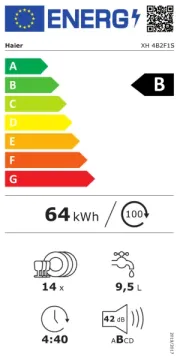
5 Augustus 2025
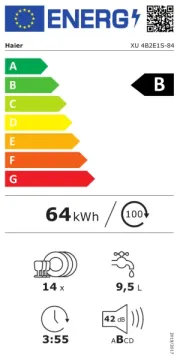
4 Augustus 2025
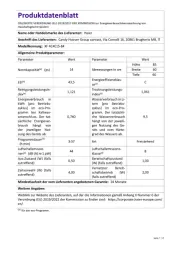
4 Augustus 2025
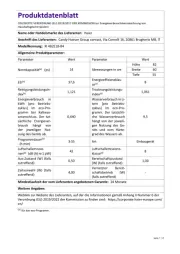
4 Augustus 2025
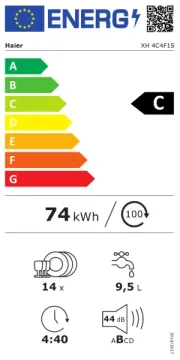
3 Augustus 2025
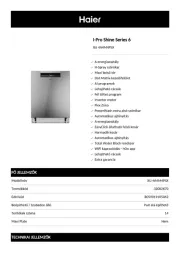
3 Augustus 2025
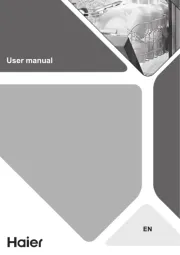
3 Augustus 2025
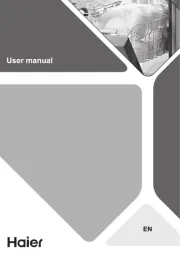
3 Augustus 2025
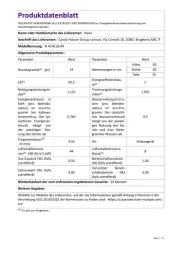
3 Augustus 2025
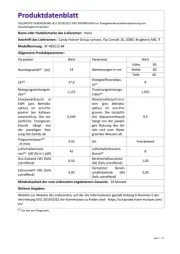
3 Augustus 2025
Handleiding Vaatwasser
- CaterChef
- Arthur Martin-Electrolux
- Silvercrest
- Kaiser
- JennAir
- Novy
- OK
- Bomann
- SPT
- Vestfrost
- IFB
- Saba
- MPM
- Listo
- Elba
Nieuwste handleidingen voor Vaatwasser
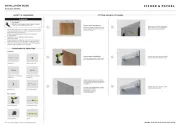
18 September 2025
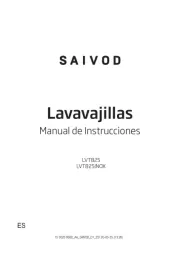
16 September 2025
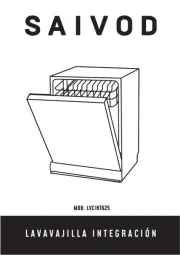
16 September 2025

16 September 2025
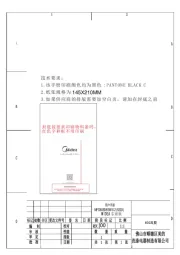
16 September 2025

15 September 2025
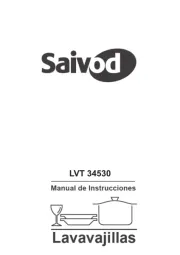
15 September 2025
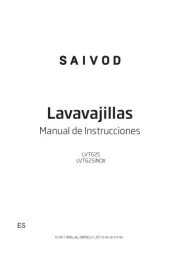
15 September 2025
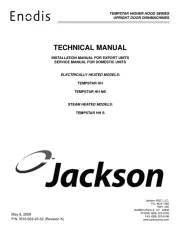
15 September 2025

15 September 2025